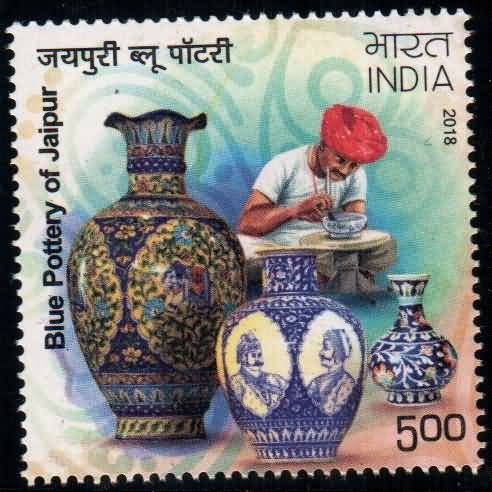Blue Pottery of Jaipur

Technical Data
| Stamp Set | Geographical Indication Registered Handicraft Products |
|---|---|
| Date of Issue | December 31, 2018 |
| Denomination | Rs. 5 |
| Quantity | 606,000 |
| Perforation | 14¼ x 14¼ |
| Printer | Security Printing Press, Hyderabad |
| Printing Process | Wet Offset |
| Watermark | No Watermark |
| Colors | Multicolor |
| Credit (Designed By) | Shri Kamleshwar Singh |
| Catalog Codes |
Michel IN 3496 Stamp Number IN 3098 Yvert et Tellier IN 3184 Stanley Gibbons IN 3582 |
| Themes | Crafts | Glass and Earthenware |
The Timeless Art of Persian Elegance
Introduction
The Blue Pottery of Jaipur is one of India’s most exquisite and distinctive handicrafts, celebrated for its vibrant cobalt-blue glaze and delicate floral motifs. Recognized as a Geographical Indication (GI) registered handicraft, this traditional art form reflects Jaipur’s royal heritage and centuries-old craftsmanship that blends Persian, Mughal, and Indian influences.
Historical Background
The art of blue pottery is believed to have originated in Persia and Afghanistan during the 14th century. It reached India with the advent of the Mughals, who brought along Persian artisans skilled in this unique ceramic technique. Later, the craft was patronized by the rulers of Jaipur, especially after their interactions with the Mughal courts through campaigns in Afghanistan. The Jaipur royals played a pivotal role in nurturing and preserving this artistic tradition, making the city the leading hub for blue pottery in India.
Craftsmanship and Technique
Unlike most pottery, Jaipur’s Blue Pottery is made using Multani Mitti (Fuller’s Earth), quartz powder, and glass powder, rather than clay. This composition makes the pottery unglazed, low-fired, and translucent, lending it a distinct charm and fragility.
The characteristic blue glaze is achieved using cobalt oxide for the blue color and copper oxide for the green shades. Artisans skillfully hand-paint traditional motifs such as flowers, birds, and geometric patterns inspired by Persian art.
The process is intricate and includes several stages:
- Preparing the dough of raw materials.
- Moulding into desired shapes.
- Drying and glazing for smoothness and sheen.
- Low-temperature firing to achieve the signature glossy finish.
Unique Features
- Low-fired and delicate, giving it a distinctive translucent appeal.
- Unglazed yet smooth, making it hygienic and suitable for daily use.
- Decorated with natural, mineral-based colors ensuring long-lasting beauty.
- Combines artistry with functionality, as it is both decorative and utilitarian.
Cultural and Artistic Significance
Blue Pottery of Jaipur beautifully symbolizes the fusion of Indo-Persian aesthetics. Its motifs—often inspired by nature and Mughal architecture—reflect harmony, peace, and elegance. Over centuries, it has evolved into a hallmark of Jaipur’s cultural identity, adorning royal palaces, homes, and handicraft exhibitions across the world.
Conclusion
The Blue Pottery of Jaipur stands as a shining example of India’s enduring artistic legacy. With its Persian origins, royal patronage, and intricate craftsmanship, it continues to enchant art lovers and collectors alike. Each piece of blue pottery is a masterpiece that carries forward Jaipur’s timeless tradition of beauty, skill, and heritage.
